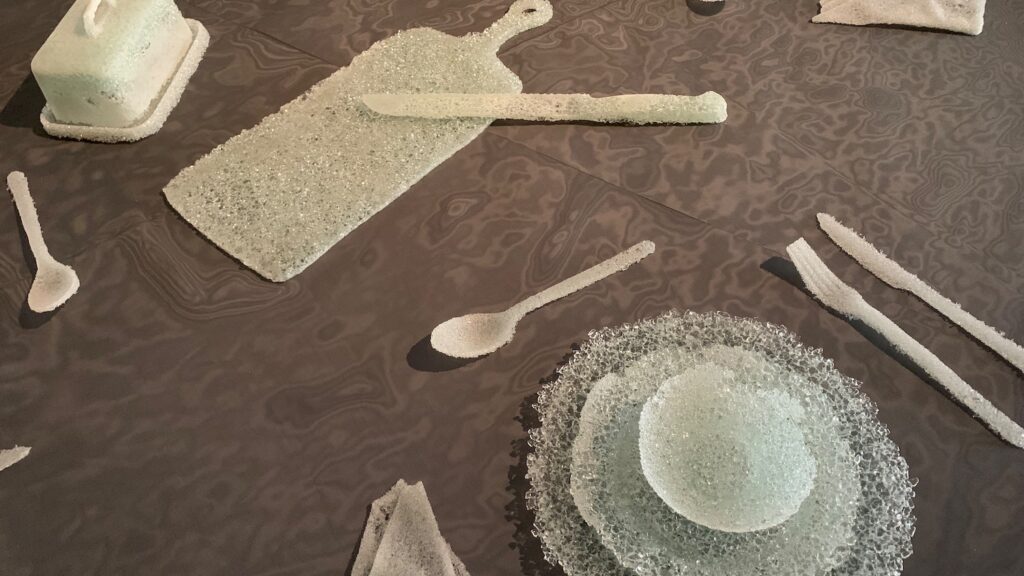You’ll find plenty to spark memories of your own in Placemarks, an exhibition that sees artists explore far flung places from childhood, former homes and old haunts in the suburbs.
Take a trip down memory lane
16 August 2023
- Reading time • 6 minutesVisual Art
More like this
- A walk with Tina Stefanou
- A blaze of glorious people
- Diving into the gothic world of Erin Coates
Placemarks, various artists, curated by Kristy Scaddan
Gallery 25, Edith Cowan University, Mt Lawley
Memory is a powerful thing, a force that provides an anchor point in our personal timeline connecting us to the here and now, and helping form a sense of who we are.
But memory can be unreliable. It can let us down and mislead us into conflict when our recall of a time or event does not match with those of others who were there.
Curator Kristy Scaddan recognises that memory is a rich field for artists to cultivate. In Placemarks she has asked a group of fellow Edith Cowan University art alumni – whose practices span a range of mediums and processes – to respond to a specific place from their past; to explore, retrieve and reinterpret those memories.
The resulting exhibition is, not surprisingly, diverse, as each artist explores far flung places from childhood, former homes and old haunts in the suburbs.

A standout in scale and concept is Louise Grimshaw’s sculptural paper installation, The Fairsky, which evokes billowing clouds with its towering spirals of folded and suspended white paper. Grimshaw recalls her family’s migration to Australia as “Ten Pound Poms”, cleverly hinting at their story with projections of family photos on the spirals. These offer glimpses of images which keep shifting, perhaps suggesting a strong grasp of memory becomes harder to hold on to, the further removed we are from its source.
Robyn Bernadt also refers to family memories of migration and dislocation. She makes strong use of reclaimed and altered paper, in this case souvenir travel guides featuring exotic overseas destinations, bringing home the sense of alienation for families who are separated by great distance.
Hugh Breslin’s focus is much closer to home as he explores wetlands in Perth’s north. His oil on canvas triptych, Yellagonga, is a strong abstract rendering of this local landmark, with his vigorous mark making and sensitive use of colour effectively mapping its life and geography.
Rebecca Hepworth takes a whimsical look at childhood in a group of deftly realised paintings and drawings that explore the sense of wonder and discovery of a child’s understanding, and misunderstanding, of the world around them.
Brianne Sharp’s Settle is an intriguing work that reproduces an entire dining setting, crockery, cutlery and more, in cast kiln-formed float glass. It is a beautiful collection filled with a sense of nostalgia for the family dining table of times past. But the fragility of the glass also seems to hint at the brittleness of those connections as well as the associated memories.

Shanti Gelmi also recreates memories of an old family home in Notions, a mixed media installation that reimagines elements of her mother’s sewing room through oversized wooden spools and needles, along with thread made from screen-printed vintage sewing patterns. Gelmi brings diverse skills to bear in this captivating scene that celebrates the joy of family skills and crafts and their passage down generations.
It is perhaps the curator herself who most effectively captures the ephemeral nature of memory. In her Impermanent series, Scaddan uses a solvent transfer process to convey to paper her photographs of abstract scenes of her childhood town. These images on various types of paper in large hanging works and small concertina artists’ books all carry a hazy, dreamy sense of shadow and light that hint at the shifting nature of memories that can get ever less reliable as we look back with increasing fondness.
All the works in this exhibition are bold attempts at nailing down a place and time, converting ephemeral moments into something more concrete. Ultimately this is a highly personal process but these themes are universal and visitors to Placemarks are likely to find plenty here to spark memories of their own.
Placemarks continues until 31 August 2023.
Pictured top is a work from Kristy Scaddan’s ‘Impermanence’ series. Photo: Kristy Scaddan and Alix Beattie
Like what you're reading? Support Seesaw.






